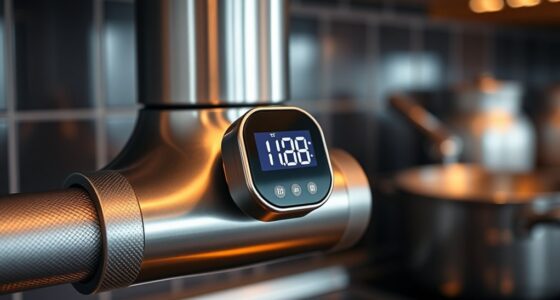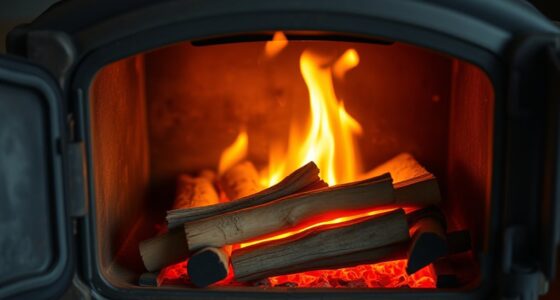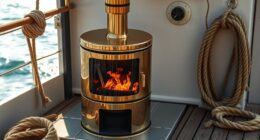You should have your chimney inspected at least once a year by a professional to guarantee safety and efficiency. If you use your fireplace more than once a week, plan on cleaning it every 3 to 4 months to prevent creosote buildup and blockages. For occasional use, a seasonal cleaning might suffice. Remember, safety is key—proper equipment and expert help make all the difference as you learn what’s best for your home.
Key Takeaways
- Have your chimney professionally inspected at least once a year to identify creosote buildup and structural issues.
- Clean your chimney every 3 to 4 months if you use your fireplace more than once a week.
- For occasional winter use, schedule a thorough cleaning once per heating season.
- Use proper safety equipment and consider professional cleaning for heavy creosote buildup or complex chimney systems.
- Regular maintenance helps prevent fires, ensures efficient operation, and maintains overall home safety.

Knowing how often to clean your chimney is vital for safe and efficient heating. Regular chimney maintenance not only helps prevent dangerous fires caused by creosote buildup but also guarantees that your fireplace operates smoothly. It’s easy to overlook this task, especially if you’re not familiar with chimney safety or the proper cleaning equipment needed. However, staying on top of chimney cleaning is one of the best ways to protect your home and loved ones.
Regular chimney cleaning is essential for safety and smooth operation of your fireplace.
Typically, you should have your chimney inspected at least once a year by a professional. An inspection reveals the amount of creosote accumulation, blockages, or any structural issues that could compromise safety. If you use your fireplace frequently—say, more than once a week—you might need to clean it more often, perhaps every 3 to 4 months. Conversely, if you only burn wood occasionally during the winter, a thorough cleaning once per season may suffice. Remember, the more often you use your fireplace, the more creosote and soot can accumulate, increasing the risk of dangerous chimney fires.
When it’s time to clean your chimney, having the right cleaning equipment is vital. Basic cleaning tools include a chimney brush suited to your flue’s size and a sturdy ladder to access the chimney top safely. You’ll also need a drop cloth or tarps to catch falling debris and a dust mask to protect your respiratory health. For more thorough cleaning, some homeowners opt for chimney cleaning logs or hire professionals who use specialized equipment like rotary brushes, vacuums, and cameras to inspect every inch of the chimney. Proper cleaning equipment ensures you remove soot, creosote, and obstructions effectively, maintaining chimney safety and peak performance. Additionally, understanding the importance of creative practice can help you approach chimney cleaning with patience and attention to detail, ensuring a thorough job.
It’s worth noting that DIY cleaning can be effective for minor buildup, but safety should always come first. Climbing onto your roof and working with potentially hazardous materials isn’t for everyone. If you’re unsure about the condition of your chimney or don’t have the proper cleaning equipment, it’s wise to hire a certified chimney sweep. They can perform thorough cleanings, inspections, and repairs, giving you peace of mind that your heating system is safe and efficient.
Frequently Asked Questions
Can I Use My Chimney Immediately After Cleaning?
Yes, you can use your chimney immediately after cleaning, but make certain it’s been properly inspected and maintained first. A chimney inspection helps identify hidden issues, and regular chimney maintenance keeps it safe and efficient. After cleaning, wait until the chimney is completely cool and clear of any debris. This way, you avoid fire hazards and ensure your chimney is ready for use, providing safe and efficient heating.
What Are Signs My Chimney Needs Cleaning Sooner?
You should schedule chimney cleaning sooner if you notice signs like excessive smoke, unpleasant odors, or soot buildup, as these affect chimney safety. Increased creosote deposits also indicate you need more frequent cleaning to prevent fire hazards. Regular inspections help you maintain the proper cleaning frequency, ensuring your chimney functions safely and efficiently. Don’t ignore these signs—prompt cleaning keeps your home safe and your chimney in good condition.
Does Chimney Cleaning Improve Heating Efficiency?
Cleaning your chimney is like giving your fireplace a fresh start, boosting its performance. Regular chimney maintenance and proper cleaning frequency remove soot and creosote buildup, which can block airflow. This improves heating efficiency, making your home warmer and reducing fuel costs. When you keep your chimney tidy, you ensure safer, more effective heating, so you can enjoy cozy nights without worrying about smoky fires or inefficiency.
Are There Different Cleaning Intervals for Gas vs. Wood Fireplaces?
Yes, there are different cleaning intervals for gas and wood fireplaces. You should schedule regular chimney maintenance and inspection for wood fireplaces every year, as creosote buildup can pose fire risks. For gas fireplaces, inspections can be less frequent—typically every 1-2 years—since they produce fewer deposits. Always follow your manufacturer’s recommendations and consult professionals to determine the best inspection scheduling for your specific fireplace type.
Is DIY Chimney Cleaning Safe for Homeowners?
You can try DIY chimney cleaning, but chimney safety is vital. Imagine climbing onto your roof with a brush and DIY tools, risking falls or inhaling harmful soot. Without proper knowledge, you may miss dangerous creosote buildup or damage the chimney structure. For safety and efficiency, it’s best to hire professionals who understand the nuances of chimney maintenance, ensuring your home stays safe and your fireplace burns clean.
Conclusion
Ultimately, cleaning your chimney twice a year is the safest bet, especially if you use your fireplace regularly. Some say cleaning more often prevents chimney fires, but evidence suggests that once a year suffices for most homeowners. notably, a 2018 study found that over-cleaning can sometimes cause more harm than good, disrupting the chimney’s natural creosote buildup that acts as a fire barrier. Trust your instincts and schedule professional inspections to keep your home safe and cozy.











